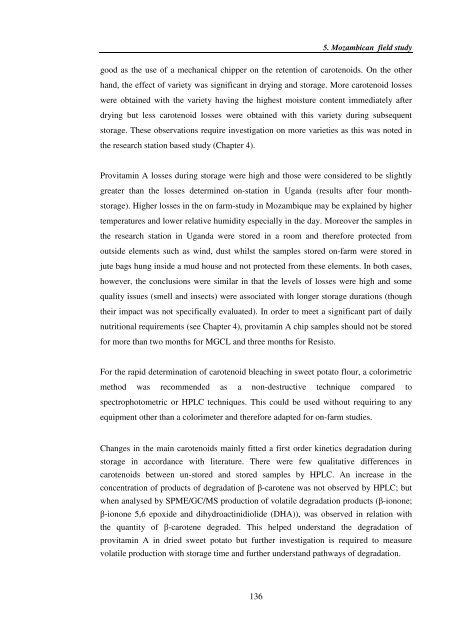Investigating carotenoid loss after drying and storage of
Investigating carotenoid loss after drying and storage of
Investigating carotenoid loss after drying and storage of
You also want an ePaper? Increase the reach of your titles
YUMPU automatically turns print PDFs into web optimized ePapers that Google loves.
136<br />
5. Mozambican field study<br />
good as the use <strong>of</strong> a mechanical chipper on the retention <strong>of</strong> <strong>carotenoid</strong>s. On the other<br />
h<strong>and</strong>, the effect <strong>of</strong> variety was significant in <strong>drying</strong> <strong>and</strong> <strong>storage</strong>. More <strong>carotenoid</strong> <strong>loss</strong>es<br />
were obtained with the variety having the highest moisture content immediately <strong>after</strong><br />
<strong>drying</strong> but less <strong>carotenoid</strong> <strong>loss</strong>es were obtained with this variety during subsequent<br />
<strong>storage</strong>. These observations require investigation on more varieties as this was noted in<br />
the research station based study (Chapter 4).<br />
Provitamin A <strong>loss</strong>es during <strong>storage</strong> were high <strong>and</strong> those were considered to be slightly<br />
greater than the <strong>loss</strong>es determined on-station in Ug<strong>and</strong>a (results <strong>after</strong> four month-<br />
<strong>storage</strong>). Higher <strong>loss</strong>es in the on farm-study in Mozambique may be explained by higher<br />
temperatures <strong>and</strong> lower relative humidity especially in the day. Moreover the samples in<br />
the research station in Ug<strong>and</strong>a were stored in a room <strong>and</strong> therefore protected from<br />
outside elements such as wind, dust whilst the samples stored on-farm were stored in<br />
jute bags hung inside a mud house <strong>and</strong> not protected from these elements. In both cases,<br />
however, the conclusions were similar in that the levels <strong>of</strong> <strong>loss</strong>es were high <strong>and</strong> some<br />
quality issues (smell <strong>and</strong> insects) were associated with longer <strong>storage</strong> durations (though<br />
their impact was not specifically evaluated). In order to meet a significant part <strong>of</strong> daily<br />
nutritional requirements (see Chapter 4), provitamin A chip samples should not be stored<br />
for more than two months for MGCL <strong>and</strong> three months for Resisto.<br />
For the rapid determination <strong>of</strong> <strong>carotenoid</strong> bleaching in sweet potato flour, a colorimetric<br />
method was recommended as a non-destructive technique compared to<br />
spectrophotometric or HPLC techniques. This could be used without requiring to any<br />
equipment other than a colorimeter <strong>and</strong> therefore adapted for on-farm studies.<br />
Changes in the main <strong>carotenoid</strong>s mainly fitted a first order kinetics degradation during<br />
<strong>storage</strong> in accordance with literature. There were few qualitative differences in<br />
<strong>carotenoid</strong>s between un-stored <strong>and</strong> stored samples by HPLC. An increase in the<br />
concentration <strong>of</strong> products <strong>of</strong> degradation <strong>of</strong> #-carotene was not observed by HPLC; but<br />
when analysed by SPME/GC/MS production <strong>of</strong> volatile degradation products (#-ionone;<br />
#-ionone 5,6 epoxide <strong>and</strong> dihydroactinidiolide (DHA)), was observed in relation with<br />
the quantity <strong>of</strong> #-carotene degraded. This helped underst<strong>and</strong> the degradation <strong>of</strong><br />
provitamin A in dried sweet potato but further investigation is required to measure<br />
volatile production with <strong>storage</strong> time <strong>and</strong> further underst<strong>and</strong> pathways <strong>of</strong> degradation.






